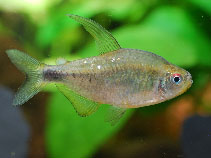|
Hyphessobrycon loweae Costa & Géry, 1994 |

|
|
photo by
Hoffmann, P. and M. Hoffmann |
| Family: | Characidae (Characins; tetras), subfamily: Stethaprioninae | |||
| Max. size: | 3.16 cm SL (male/unsexed) | |||
| Environment: | benthopelagic; freshwater; depth range 1 - 2 m | |||
| Distribution: | South America: Upper Xingu River basin. | |||
| Diagnosis: | Dorsal soft rays (total): 19-20; Anal soft rays: 22-23; Vertebrae: 34-35. This species is differentiated from its congeners in having the following characters: elongated dorsal fins in males; caudal spot diamond-shaped; humeral spot vertically elongated; maxillary teeth hexacuspidate; anal fin rays 22-23; lateral line scales 30-31 (Ref. 72430). Description: Dorsal fin rays ii,8,I; anal fin rays 22-23 (iii-iv, 19-20); pectoral fin rays I,9; pelvic fin rays I,6-7. Color in life dark gray caudal spot, faintly reaching tip of median caudal fin, anteriorly as a pale stripe continuous with the faint humeral spot; body sides and head golden, mandibular region orange, nostrils red, iris red above, bright metallic blue below; dorsal fin pale crimson with a dark gray line on anterior edge; adipose, pectoral, pelvic, and anal fins orange, a dark gray line on distal margin of anal and another similar line on anterior margin of pelvic; caudal fin yellow, with a bright yellow spot on the base of each lobe (Ref. 72430). | |||
| Biology: | Inhabits shallow, clear water stream located in the Cerrado region; sandy bottom with small rocks and sparse aquatic vegetation (Ref. 72430). | |||
| IUCN Red List Status: | Least Concern (LC); Date assessed: 07 November 2018 Ref. (130435) | |||
| Threat to humans: | harmless | |||